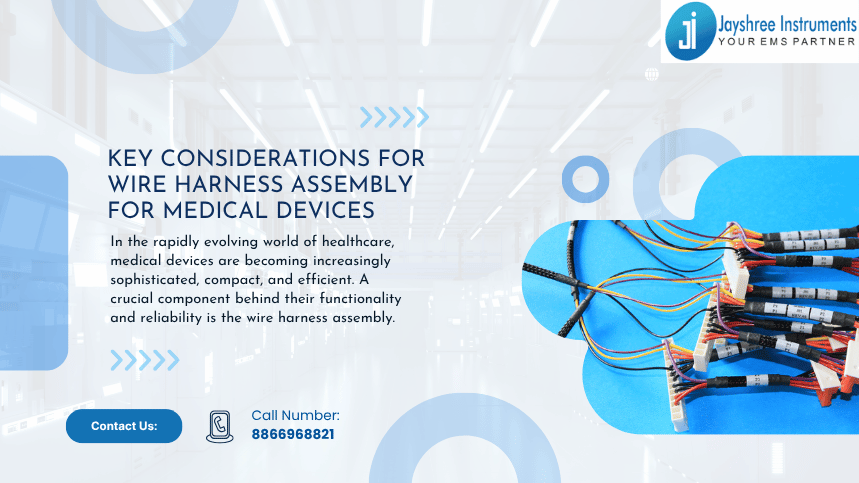In the rapidly evolving world of healthcare, medical devices are becoming increasingly sophisticated, compact, and efficient. A crucial component behind their functionality and reliability is the wire harness assembly, which is a well-organized bundle of wires, connectors, and terminals made by a professional wire harness assembly manufacturer that transmits signals and power throughout the device. Given the sensitive nature of medical applications, the assembly of wire harnesses for medical devices demands meticulous planning, high precision, and strict adherence to quality standards.
In this article, we explore the key considerations for wire harness assembly in the medical device industry to ensure safety, durability, and compliance.
-
Compliance with Industry Standards and Regulations
One of the foremost priorities in medical wire harness assembly is regulatory compliance. Devices must meet stringent standards set by organizations. Any deviation can lead to product recalls, legal consequences, or worse, compromised patient safety. Manufacturers must follow cleanroom protocols and document every step of the assembly process.
-
Selection of Biocompatible and Medical-Grade Materials
Materials used in wire harnesses must be biocompatible, non-toxic, and durable under sterilization. These materials must withstand exposure to moisture, bodily fluids, cleaning agents, and extreme temperatures. Additionally, for devices used in or near the body, low-outgassing and non-carcinogenic materials are crucial.
-
Miniaturization and Compact Design
Modern medical devices like pacemakers, insulin pumps, and portable monitors demand miniaturized wire harnesses. Space is limited, yet reliability cannot be compromised. Key strategies for compact design include:
- Flexible flat cables (FFCs)
- High-density connectors
- 3D harness routing and custom overmolding
Engineers must carefully plan wire routing to avoid signal interference and maintain mechanical strength, especially when devices are subject to frequent movement or transport.
-
Electrical Performance and Signal Integrity
In medical applications, even a minor glitch in signal transmission can lead to serious consequences. Wire harnesses must ensure:
- Accurate signal transmission
- Low resistance and high conductivity
- Shielding against EMI and radio-frequency interference (RFI)
Testing for continuity, insulation resistance, and high-pot testing is essential to validate performance. Some advanced harnesses also incorporate data transfer lines or fiber optics for high-speed communications in imaging or diagnostic equipment.
-
Customization and Device-Specific Solutions
No two medical devices are exactly alike. Hence, wire harness assembly often requires tailored solutions. Engineers work closely with OEMs (Original Equipment Manufacturers) to:
- Determine exact connector types
- Match cable lengths to device layout
- Add labeling and color-coding for quick identification
Custom overmolding and strain relief designs are also common to improve durability and ergonomics, especially in handheld or wearable medical devices.
-
Sterilization Compatibility
Medical devices often need to be sterilized repeatedly. Wire harnesses must be compatible with sterilization methods. Materials and adhesives used in the harness must not degrade, warp, or release harmful residues after sterilization. Early collaboration between materials scientists and harness designers helps avoid these pitfalls.
-
Reliability and Longevity
Medical devices must function flawlessly over extended periods. This makes long-term reliability a key design focus. Common best practices include:
- Redundant wiring paths in mission-critical systems
- Crimped rather than soldered joints for improved mechanical integrity
- Strain relief boots and grommets to reduce mechanical stress
Conducting accelerated aging tests, vibration testing, and mechanical cycle tests helps validate the durability of the wire harness before product release.
-
Traceability and Quality Assurance
In medical manufacturing, traceability is vital. Every wire, connector, and component must be traceable to its source, batch, and assembly operator. This is essential for:
- Root cause analysis in case of defects
- Quality audits by regulatory bodies
- Maintaining consistent production quality
Advanced manufacturing facilities use barcode systems, digital documentation, and automated testing stations to maintain traceability throughout the wire harness life cycle.
-
Cleanroom Assembly and Contamination Control
Cleanroom environments with ISO Class 7 or higher are often used for assembling wire harnesses meant for invasive or implantable medical devices. These environments:
- Prevent contamination from dust, microbes, or particulates
- Ensure static control to protect sensitive electronics
- Allow for precision assembly with minimal human contact
Employees are trained to follow strict hygiene protocols, and specialized tools are used to handle micro-sized connectors and delicate wires.
-
Cost-Efficiency and Scalability
While safety and precision are top priorities, cost-efficiency cannot be ignored. Choosing suppliers who can provide:
- Rapid prototyping
- Low-volume and high-volume production
- Automated assembly solutions
It helps control costs while maintaining quality. Investing in long-term supplier partnerships also ensures supply chain stability and faster time-to-market for new medical innovations.
Conclusion
Wire harness assembly for medical devices is a high-stakes process requiring a blend of engineering precision, regulatory compliance, and adaptability. Every aspect, from material choice to signal integrity and sterilization compatibility, must be carefully designed to meet the rigorous demands of modern healthcare technology.
By partnering with experienced manufacturers who specialize in medical-grade wire harness solutions, OEMs can ensure their devices are not only functional but also safe, reliable, and ready for global deployment.

Recent Comments